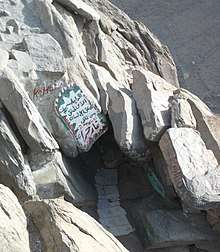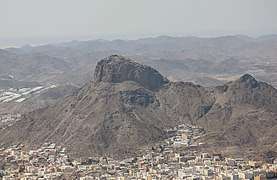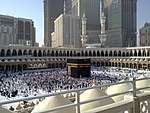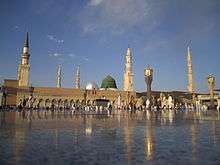Jabal al-Nour
Jabal an-Nour (Arabic: جَبَل ٱلنُّوْر, romanized: Jabal an-Nūr, lit. 'Mountain of the Light' or 'Hill of the Illumination') is a mountain near Mecca in the Hejazi region of Saudi Arabia.[1] The mountain houses the grotto or cave of Hira' (غَار حِرَاء), which holds tremendous significance for Muslims throughout the world, as the Islamic Nabī (Prophet) Muhammad is said to have spent a great deal of time in this cave meditating, and it is widely believed that it was here that he received his first revelation, which consisted of the first five ayats of Surah Al-Alaq from the angel Jibra'il (as is pronounced in certain Quran recitation schools and some Arab tribes; also known as Gabriel).[2] It is one of the most popular tourist attractions in Makkah. The mountain itself is barely 640 m (2,100 ft) tall; nonetheless one to two hours are needed to make the strenuous hike to the cave. There are 1750 steps to the top which, even for a fit individual, can take anywhere between half an hour and one-and-a-half hours.
| Jabal an-Nour | |
|---|---|
.jpg) Jabal al-Nour in the vicinity of Mecca | |
| Highest point | |
| Elevation | 642 m (2,106 ft) |
| Coordinates | 21°27′29″N 39°51′41″E |
| Naming | |
| Native name | جَبَل ٱلنُّوْر (Arabic) |
| Geography | |
 Jabal al-Nour Location of Jabal al-Nour in Saudi Arabia | |
| Location | Makkah Province, Hejaz, Saudi Arabia |
| Parent range | Hijaz Mountains |
Etymology
Since this is where Muhammad is said to have had his first revelation and received the first verses of the Quran, the mountain was given the title Jabal an-Nūr ("Mountain of the Light" or "Mountain of the Enlightenment"). This experience is sometimes identified with the beginning of revelation; hence the present name.[3] The date of the first revelation is said to be during the night on August 10, 610 A.D. Or, monday the 21st of Ramadan, making Muhammad 40 lunar years, 6 months and 12 days of age, i.e. 39 Gregorian years, 3 months and 22 days.[4]
Appearance
One physical feature that differentiates Jabal al-Nour from other mountains and hills is its unusual summit, which makes it look as if two mountains are on top of each other. The top of this mountain in the mountainous desert is one of the loneliest of places. However, the cave within, which faces the direction of the Kaaba, is even more isolated. While standing in the courtyard back then, people could only look over the surrounding rocks. Nowadays, people can see the surrounding rocks as well as buildings that are hundreds of meters below and hundreds of meters to many kilometers away. Hira is both without water or vegetation other than a few thorns. Hira is higher than Thabīr (ثَبِيْر),[lower-alpha 1] and is crowned by a steep and slippery peak, which Muhammad with some companions once climbed.[7]
Cave of Hira

Taking 1750 walking steps to reach, the cave itself is about 3.7 m (12 ft) in length and 1.60 m (5 ft 3 in) in width.[2] The cave is situated at a height of 270 m (890 ft).[8] During the season of Ḥajj ('Pilgrimage'), an estimated five thousand visitors climb to the cave daily to see the place where Muhammad is believed to have received the first revelation of the Quran on the Night of Power by the angel Jibreel.[8] The majority of Muslims do not consider visiting the cave as an integral part of the Hajj. Nonetheless many visit it for reasons of personal pleasure and spirituality, and though some consider it a place of worship, this view conflicts with Salafist interpretations of Islamic ritual. While the cave plays an important role in As-Sīrah an-Nabawiyyah (The Prophetic Biography), it is not considered as holy as other sites in Mecca, such as Al-Haram Mosque, and so under most interpretations of Islam, the same reward is received for praying here as any other place in Mecca.
Before Muhammad's first revelation, he was said to have pleasant dreams. Among these dreams were signs that his Prophethood was starting to appear, and signs that the stones in Mecca would greet him with the Salaam. These dreams lasted for six months.[4]
An increasing need for solitude led Mohammed to seek seclusion and meditation in the rocky hills which surrounded Mecca.[9] There he would retreat to the cave for one month, each year, engaging in taḥannuth (تَحَنُّث).[lower-alpha 2][3][12] He would take provisions along with him during this retreat, and would feed the poor that would come to him. Then before returning home to his family for more provisions he would circumambulate the Kaaba seven times, or however many times Allah willed; then he would go home.[12]
Gallery
 People entering the Cave of Hira
People entering the Cave of Hira Overview of Jabal an-Nour
Overview of Jabal an-Nour
See also
- Biblical Mount Sinai
- Cumorah
- Holiest sites in Islam
- Sacred mountains
- Sarat Mountains
References
- "Jabal al-Nour (The Mountain Of Light) and Ghar Hira (Cave of Hira)". 16 September 2015.
- "In the Cave of Hira'". Witness-Pioneer. Archived from the original on 2008-02-15. Retrieved 2018-04-11.
- Weir, T.H.; Watt, W. Montgomery. "Ḥirāʾ". In Bearman, P.; Bianquis, Th.; Bosworth, C.E.; van Donzel, E.; Heinrichs, W.P. (eds.). Encyclopaedia of Islam (2nd ed.). Brill Online. Retrieved 7 October 2013.
- Mubārakpūrī, Ṣafī R. (1998). When the Moon Split. Riyadh.
- "T̲h̲abīr", Encyclopedia of Islam (2 ed.), Brill, 2017, retrieved 2018-04-11
- Schadler, Peter (2017). "4". John of Damascus and Islam: Christian Heresiology and the Intellectual Background to Earliest Christian-Muslim Relations. Brill. p. 158. ISBN 978-9004356054.
- Weir, T. H.. "Ḥirāʾ." Encyclopaedia of Islam, First Edition (1913-1936). Edited by M. Th. Houtsma, T.W. Arnold, R. Basset, R. Hartmann. Brill Online, 2013. Reference. Augustana College. 07 October 2013 <http://referenceworks.brillonline.com/entries/encyclopaedia-of-islam-1/hira-SIM_2820>
- "Archived copy". Saudi Tourism. Archived from the original on 2011-10-08. Retrieved 2018-04-11.CS1 maint: archived copy as title (link)
- Peterson, Daniel C. (2013). Muhammad, prophet of Allah. Grand Rapids, Mich.
- "Taḥannut̲h̲", Encyclopedia of Islam (2 ed.), Brill, 2017, retrieved 2018-04-11
- Kister, M. J. (1968), ""Al-Taḥannuth": An Inquiry into the Meaning of a Term" (PDF), Kister.huji.ac.il, pp. 223–236, retrieved 2018-04-11
- al-Tabarī, Abū Ja'far Muhammad B. Jarīr (1988). Watt, W. Montgomery; McDonald, M.V. (eds.). Ta'rīkh al-rusul wa'l-mulūk [The history of al-Tabarī]. 6. Albany, N.Y.: State University of New York Press.
External links
- 3D Tour of Hira Cave
- 360° Virtual Tour of Hira Cave
- In pictures: Hajj preparations (Pictures #4 and #5 are of Jabal an-Nūr and the Hira cave)
.jpg)




